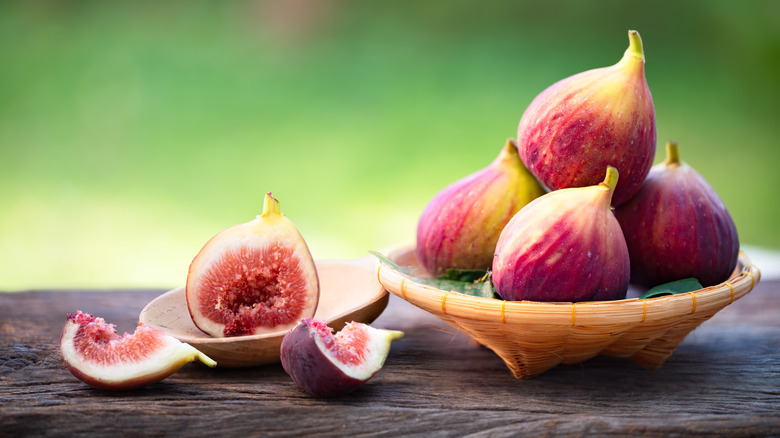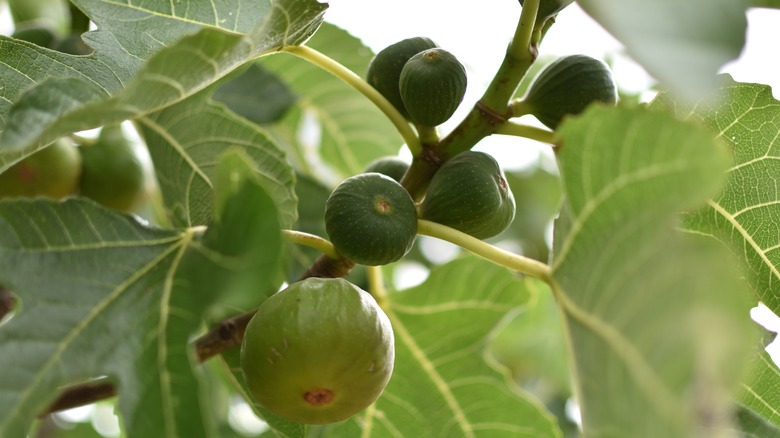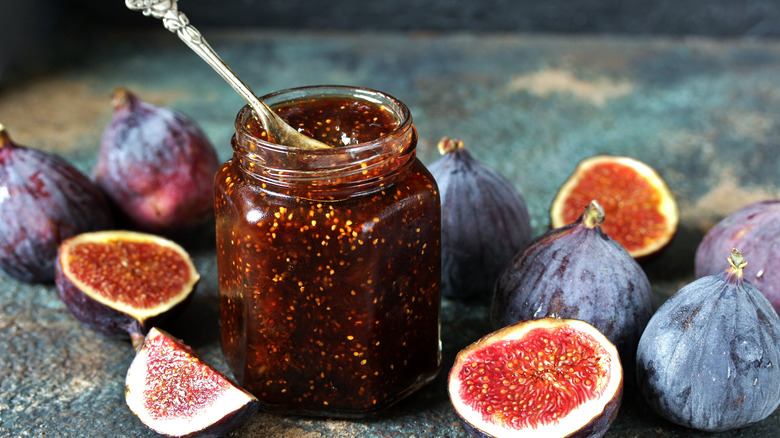You'll Probably Never Guess What Figs Actually Are
There are few foods so steeped in history as the fig. The deep purple Mission fig arrived in California in 1769, per The Sun Sentinel, but it is believed that the fruit originated in Asia before spreading to the Mediterranean region. It was there that the ancient Greeks and Romans revered the tiny, pear-shaped sweets. Fig leaves are even mentioned in the story of Creation in the Bible's Old Testament with some religious and historical scholars believing that the forbidden fruit eaten by Adam and Eve was not an apple as depicted in art and storybooks but, rather, a fig (via The Spruce Eats).
The Spruce Eats notes that in several major religions, figs symbolize fertility, wealth, blessings, and peace. As a food source, ripe figs have a soft, edible skin covering a very sweet, brightly colored interior of soft fruit punctuated by a subtle crunch of edible seeds. Sometimes a fig will be so ripe that its juices ooze out of the skin, inviting the eater with a glistening sparkle that may be reminiscent of honey. Fresh or dried, figs are used in desserts, as a compliment to cheese on charcuterie boards, and make a pleasant contrast for savory dishes featuring meat. While Americans are most likely to find Black Mission, Brown Turkey, Kadota, Calimyrna, and Adriatic figs, there are hundreds of varieties around the world (via The Spruce Eats). Figs remain one of the globe's most beloved fruits ... but are they really even a fruit?
One man's fruit is another man's flower
Fruit trees produce blossoms that need to be pollinated by insects in order for fruit to grow. However, fig trees produce no such blossoms. You might be surprised to learn that figs are technically inverted flowers, per Huff Post. The flowers are actually produced inside the fig. Those crunches that you get when you eat a fig? Those are actually the fruit/seeds inside of the flower. Since fruit is technically produced, there still needs to be a means of pollination and that's where the production of the fig really gets interesting: Enter fig wasps.
Fig wasps are responsible for making sure figs are grown. The female wasp enters a male fig flower through a small opening to lay eggs. Inside the fig, her male offspring chews its way out but soon dies because they are born without wings. Female offspring, who are equipped with wings, find their way out and are covered in pollen. While that process continues, sometimes female wasps accidentally land on female figs. They also allow the wasps to enter through tiny openings but there is no room inside for her to lay eggs and no way for her to get out. With the pollen she has on her, she is able to pollinate the flower and fig is produced, per The Atlantic. It is the female figs that consumers eat. So if you're wondering if you've been eating dead wasps, the answer is kind of.
Not as bad as you think
Before you swear off figs forever, know this: The incredibly small female wasps are totally digested with the fruit's enzymes in the process of ripening, per Bon Appetit. For thousands of years, the sole purpose of the fig wasp has been to pollinate and produce these delicious morsels for humans and animals to enjoy. In fact, according to Bon Appetit, the female fig wasp rarely has a lifespan of more than two days. She does her job, sacrificing herself in the process. That's worth a little culinary respect, is it not? Furthermore, according to Huff Post, over 95% of figs grown in California (where most of the nation's figs come from) are now self-pollinating.
According to California Figs, the state's figs have a growing season of mid- to late-summer, but you can find dried figs any time. Figs can also be found in jam and paste, making it easy to cook with these enduring fruits (or flowers?) all year round.


